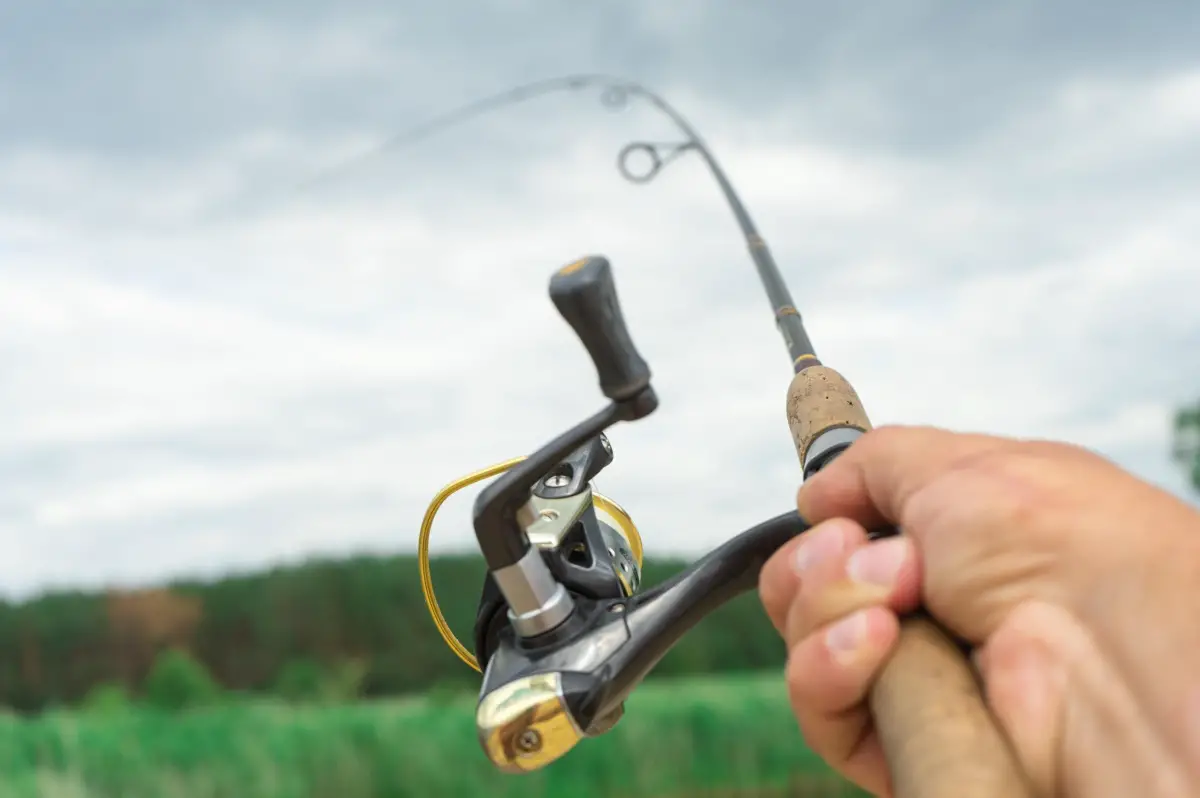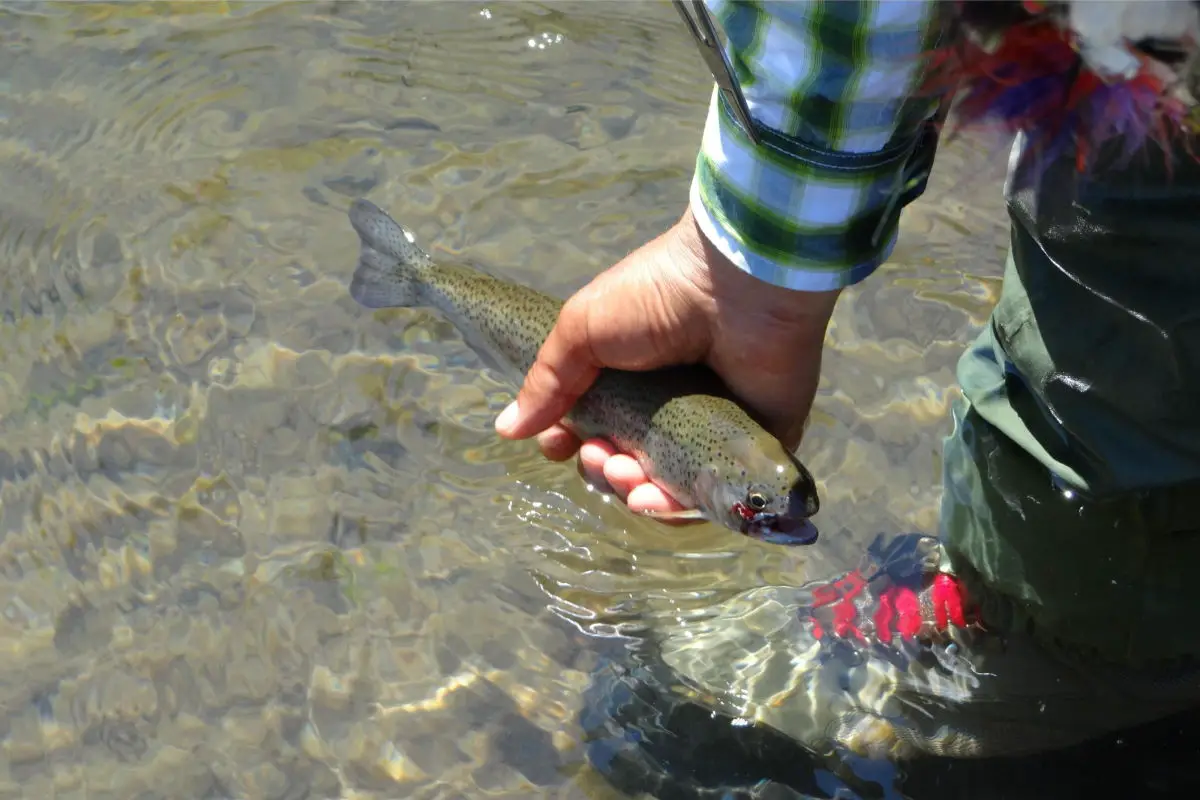Fishing streams for rainbow trout is enjoyable and simple to do. While fly fishermen often fish streams for trout, there are options that don’t require a fly rod.
One simple fishing technique is using the rooster tail lure. Casting a rooster tail for rainbow trout is a simple yet deadly way to find trout in streams. Also, the rooster tail lure is affordable and can be easy to fish for beginners.
This article will show you the steps and tricks to fishing a rooster tail for trout.
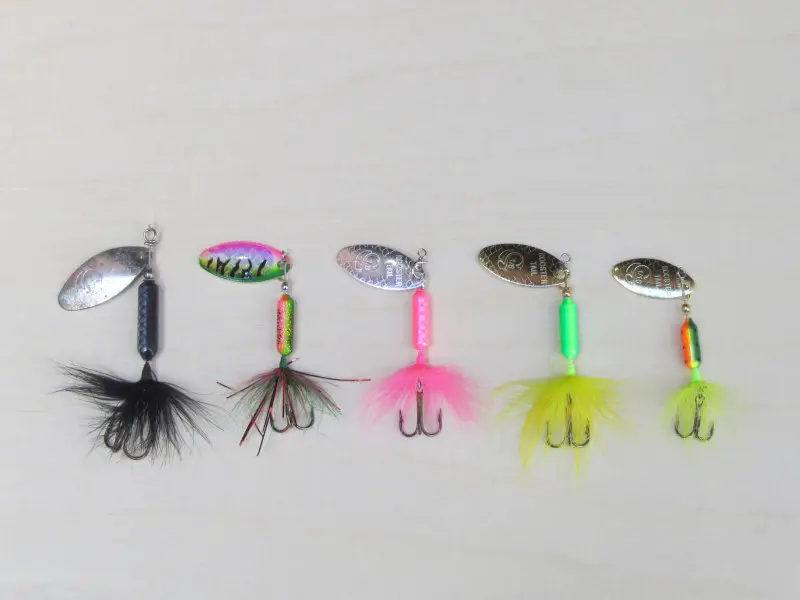
What Is a Rooster Tail?
Created in the 1950s, the rooster tail is a lure built with a spinning blade, elongated body, and a hackle tail above a treble hook.
The design leads to a pulsing or thumping sensation in the water around the lure’s tail. The rooster tail is one of the most versatile baits as it has the potential to catch almost any freshwater fish.
What Colors are Rooster Tail Lures?
The rooster tail comes in various body colors: orange, white, yellow, black, pink, and green. Along with these standard colors are many variations, such as green and orange with black dots (this is called the fire tiger).
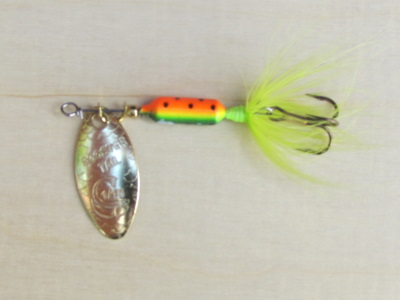
As for blade colors, the standards are brass, copper, and nickel, but they also make some multi-colored blades that are more suited to bass and walleye.

What size do Rooster Tails come in?
Roaster Tails come in various sizes, starting at 1/32 ounce and going up to 1 ounce. The extensive range of sizes allows you to find the perfect rooster tail for any type of water you may want to fish.
Yakima bait makes some great Rooster Tail All-star Packs that includes some of my favorite colors, like black and rainbow.
What is the Best Color Rooster Tail for Casting in a Stream?
Black Rooster Tails are our all-time favorite however, the color of rooster tails should be determined by the water clarity and the sunlight that day. Throw a natural-looking color in clear water, such as dark green or silver, especially on sunny days. This decreases the chance of spooking the rainbow trout and typically matches the color of their food source better.
If a stream is muddy or the clouds are limiting the sunlight, throw a flashier color such as chartreuse or orange. This will allow trout to locate the rooster tail quicker, resulting in more hookups.
What is the Perfect Size Rooster Tail for Casting in a Streams?
Casting rooster tails in streams for trout requires an understanding of lure sizes. The ideal size for a rooster tail when targeting stream trout is the 1/16 oz or the 1/8 oz lure. The 1/8 oz rooster tail is perfect as the profile is small enough not to scare the trout but allows for a respectable casting distance. The 1/16 oz rooster tail is used when fishing shallow streams or in tight casting quarters. This allows for more control and a slower sink rate in the shallow stream.
What is the best size rod and reel for casting rooster tails?
The best size rod is a 6’6″ medium to fast action rod. The best size reel to pair with the rod is a size 2000 reel intended for 2-6 lb monofilament line.
Keeping the rod length under seven feet allows for smoother casting as trees and bushes can crowd the stream. A 6’6″ rod brings versatility as it provides casting power yet offers access to tighter spaces.
Reel sizes are labeled in increments of 500. A 1000-2000 size spinning reel provides the proper amount of line to be spooled and pairs well with the rod for casting. It is important to pair reels and rods appropriately, or you may run into casting issues.
Tip: When choosing your fishing line, go with a 6-pound monofilament. Avoid using braid and fluorocarbon lines on an ultralight reel. Both of these fishing lines have issues when it comes to trout fishing.
Braided line is too easily seen, while fluorocarbon line doesn’t spool easily on such a light setup. Monofilament is a necessity when casting for rainbow trout with a rooster tail. This rod and reel setup is known as ultralight or light setup.
What Are the Best Techniques for Casting Rooster Tails to Catch Trout?
The cast and retrieve technique is the best method when casting a rooster tail for rainbow trout in a stream. Simply cast the rooster tail into the stream and slowly retrieve it with the rod tip down at a steady pace.
While the cast and retrieve method is the easiest way to fish a rooster tail, there are some factors that you must consider. Not all streams are the same, and their differences must be accounted for when casting a rooster tail.
Streams With Fast Current Next to Slow Water
If a stream has a fast current next to slow water, that point where the slow water meets the current is called a seam. Trout love to feed in seams, and you should cast upstream right into the seam. Trout naturally face upstream to feed on the insects and small fish that are swept down toward them. By casting upstream and fishing it down in the seam, you give the rooster tail the best opportunity to get a bite.
Casting the rooster tail into the current next to the seam is always a good idea. The current will briefly spin the rooster tail for you and guide it into the seam. If it is in the current, don’t reel it in immediately but let the current do the work for you.
Streams With Fast-Moving Water
If a stream is all fast-moving water, don’t pass it by. Instead, change up your technique and cast across right next to the other bank. Without reeling much, guide the rooster tail across the stream and let the current carry it to the other side. Swinging a rooster tail from side to side in a fast-moving stream can be extremely productive and enjoyable.
Streams With Slow-Moving Water
Another technique is when the water in the stream is slow-moving or even at a standstill. You need to change the cast and retrieve method for this water type. Instead of just casting and retrieving the rooster tail, allow it to sink when it hits the water.
Several methods can be used after it has fallen through the water column a bit. Start by dragging it a few feet and then pausing to reel in the slack. This allows the rooster tail to swim and fall, making it almost pop off the bottom.
Another technique is fishing the rooster tail fast, slowing down, and speeding up. These can entice a bite out of a trout even on the worst of fishing days. Varying the rooster tail’s speed and fishing different water depths is a trial-and-error method when searching for trout.
Remember that trout hold near the bottom of the stream, face upstream to search for food, and may need to see several different retrieval methods before they bite the rooster tail.
Tip: Many fishermen fish the rooster tail wrong on the simple cast and retrieve method. They end up retrieving the rooster tail too fast and missing out on trout they potentially could have caught.
Once the rooster tail hits the water and sinks to the depth you want, quickly reel it a bit for a second or two. You should feel the thumping of the rooster’s tail as you reel. Once the rooster tail is spinning, you can slow down your retrieve and allow the trout a few seconds to decide to bite or not.
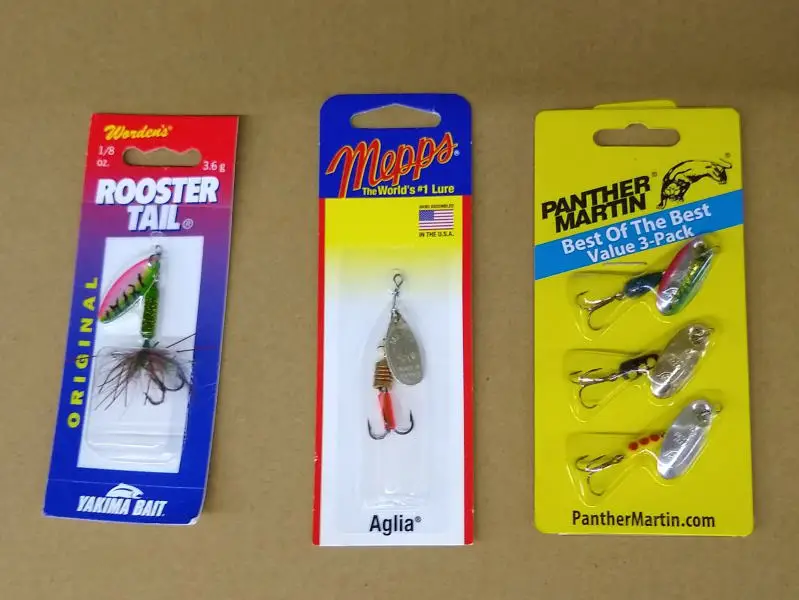
Other Lures You Can Cast for Rainbow Trout In a Stream
There must be one thousand different lures that you can cast for rainbow trout in a stream, but Mepps and PantherMartins are two that I have used. Of course, I like to add variety to my tackle box, but the main reason I picked these two types is that my local hardware store has them in stock.
I know that is not the soundest reason to pick a lure, but both of these work great, and after I lose a few snagging the stream bottom, I can stop on my way home and buy replacements. Also, I like buying variety packs to start my selection, it is usually cheaper than buying them individually, and it removes the difficulty of what to start out with.
Final Thoughts
As you can see, rooster tails are one of the most versatile fishing lures for trout. Even though the methods of fishing a rooster tail are simple, don’t forget these factors.
Choosing the right rod and reel, the rooster tail size, and finding a retrieval method the rainbow trout want is crucial.
Rooster tails are not only for casting! They can be fished behind a trolling rig.
I like to add a 1/4oz black roost tail in place of my worm on sunny days when the bite can be few and far between. Check out my article, Best Lake Troll for Rainbow Trout.
